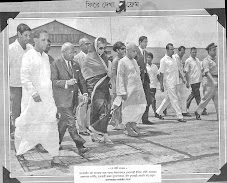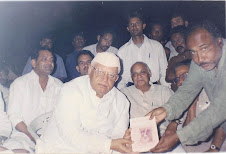VODAFONE- Langoti Chhaap Supreme Court – Shame, Corrupt, Hurt India
Honorable Members of Parliament,
Executive Summary: - 1. Supreme Court in 65 years since Independence has rendered India a Misgoverned, Poor, Hungry and Malnutrition Nation where Crooks Thrive. 2. Most funnily Date of Birth is as recorded in Matriculation Certificate not actual birth and time recorded in Hospitals, 3. Tenants are allowed to inherit tenancy perpetually at Owners Expense, 4. SC doesn't recognize written contracts when even verbal promises in a just society need by honored, 5. India doesn't protect IPR of Indians (Film are Exception), 6. Indian & Foreign companies operating in India buy and sell in Foreign Countries (Vodafone) without any tax liability in India, 7. 70% of Indian Population in Villages gets 10% of Bank Credit, 8. 80% Farmers, 95% MSMEs don't get bank credit contributing to 80% employment and livelihood, depend on moneylenders, 9. 0.01% (Mainly Average Qualified Bania Traders Had Not Invented A Single Technology) own 96% Equity in Listed Companies, 10.
Companies adding 5% value get 80% Bank Credit, 11. Tax Foregone meant for Promoting Employment and Industry exceed Rs.6,00,000 crores – 60% pocketed by companies achieving 5% to 20% Value Additions and pocketed by 0.01%, 12. Municipalities are Most Corrupt most habitations are without Sewage, Water Supply, Hospitals, Schools Colleges, 13. Coastal Regulations and ASI act together means 25% or more city Residential Areas comes under restricted development and no development. 14. 800m Farmers can't sell produce directly to 1200m consumers – forced to go through 2-7 middlemen sell produce at below cost pf production – actually Traders contributing nothing get more bank credit than all farmers. 15. Farmers can't store and process food. 16. Rural India provide all Minerals and land for Dams and Power project but don't get Just and Fair share in Electricity (even 12% free power is diverted to cities) and Value of Minerals and Metals produced.
17. Transferring money from one project to another is routine and Inside Trading is rampant not a fraud in India Large Companies starting with 10% equity now own over 50%. 18. Corporate Inflating Capitalization many times and procuring supplies from sister companies at inflated cost are not Punished. 19. Companies hiring Inexperienced Staff at a third of normal wages is Common. 20. Companies don't observe Quality & Service Standards.
Above Issues Are Contributing Subject Matter of BLACK MONEY in Foreign Countries, Corruption and Hunger & Malnutrition points to Failure of Supreme Court in addressing them due Unfair Economic Structure when Supreme Court is Empowered by our Constitution to address above 1-20 subjects. With above Malpractices and Distortions economic progress is impossible.
There is no Finance Commission to ensure Just & Fair allocation of public money with Finance Ministry in Center and State Budgets and RBI Regulated Banks.
I waited for two days for Prashant Bhushan or Kejriwal to respond to the judgment saving Vodafone Rs.11,000 crores liability. I don't recall a single instance in 30 years of Supreme Court Judgment had made India proud but in this particular case it seems Supreme Court was on the payrolls of Vodafone, in doing so Judgment extinguished any hope of review and didn't pointed out the improvements required to plug loss of revenue to India, virtually giving license to evade taxes in India promote overseas transactions.
Ø India was not getting any revenue from $300b invested by Indian companies in foreign countries funded by Indian Money and with Vodafone order it made sure $250b FDI too shall not earn any Transaction Tax in India, these figures are to double in 3-4 years.
Ø It laughable with this kind of judgment 99.999% Indians would have no holding in over $Trillion foreign transactions even as Companies Are Using money of 99.999% Indians to their enrichment.
http://www.essar.com/upload/pdf/EOL_AR_2010-11.pdf
Ø In earlier message I had exposed how 0.09% Hold 95% equity in ESSAR REFINERY but remaining 99.99% small investors are yet to get first dividend in 10 years.
On the eve of retirement Chief Justice had SEXED up his CV so that on retirement he is ready to take up National or International assignments and continue in service for another 15-20 years without really contributing anything to judicial service. In all the Judiciary is most Corrupt, Irresponsible and Worst in the World.
http://supremecourtofindia.nic.in/judges/sjud/shk.htm
'Born on 29th September 1947. Enrolled as an Advocate on 10th September 1974. Practiced in the Bombay High Court, both on the Original Side and Appellate Side in Suits, Letters Patent Appeals, Writs, matters under Negotiable Instruments Act, Detention Matters, matters under Bombay Rent Act, matters under Bombay Municipal Corporation Act including trials concerning fixation of rate able value, matters under Maharashtra Land Revenue Code including trials concerning valuation of properties for the purposes of fixation of NA assessments, challenge to the validity of notifications fixing Standard Rent, appeared in AOs, First Appeals under the BMC Act, Second Appeals as also in Land Acquisition References under the Land Acquisition Act as also in matters under Bombay Land Requisition and Acquisition Act. This is apart from the practice in Industrial Law and Services Matters. Appeared as a counsel for the Department in Tax matters. Appeared as a counsel for
BMC in matters concerning rate able value and Octroi. Appeared as a counsel for Bharat Petroleum Corporation and Hindustan Petroleum Corporation in High Court and Supreme Court in connection with service matters including disputes concerning framing of Pension Rules. Also appeared for the Management and Unions in matters under Industrial Disputes Act, 1947 and ULP Act, 1972.'
This professional inventor is Shocked to find the Spineless Conduct of Supreme Court when it comes to Corporate like Reliance, Vodafone, in punishing RIL for Hoarding on to 25 very large Offshore Blocks promising 40 times more Oil & Gas from just one discovery in about 100 sqkm of over 10,000 sq.km of an D-6 Offshore block – production loss alone from One or Two blocks including GSPC exceed $500b in avoiding imports of petroleum.
1. In the Judgment downloaded from Business Standard you will be shocked to discover though Physical Assets of Essar Hutch were are in India but most of the shareholding transactions materialized in foreign tax heavens.
Ø Out of scores of transactions just one deal was worth over $12b, Gross Values of all transaction could be in $40b but India didn't get a penny out of them when all the Operations were in India.
2. It is amazing Supreme Court was quick to put in jail 2G SCAM officials on the basis of BOGUS loss estimates – 2G is outdated technology – all SC judges have Google search facility – there is not even a Rs.1000 crore 2G auction in the world in 2010 but Maliciously Hammered Rs.1,76,000 crore loss that was actually reported by DG Telecom Audit to around Rs.2000 crores only.
Ø SC Judges have several computers with Self and their Personal Staff – they cant play DUMB, in matters of Defense or National/International importantace.
3. Residential Properties. It is scandalous Rent Laws meant to protect displaced persons of 1947 partition for one generation continue to be ABUSED for 3-4 generations.
http://supremecourtofindia.nic.in/assets/shk.pdf
Ø It scandalous CJI occupies THREE properties, Official Residence plus two Rented Properties as per his Affidavit.
Ø It is scandalous son of CJI is occupying property rented to his late maternal grandfather.
Ø It is scandalous CJI is Occupying an Illegal High Rise Building in Mangroves in violation of Coastal Regulations.
Ø It is scandalous, CJI to EVADE taxes Residential flat worth Rs.10 crores is purchased as RENTED property worth Rs.20 lakh. This is no less SCAM than Adarsh Society Scam.
4. ASI REGULATE 20% of Delhi – Rs.10,00,00,000 crores Restriction:
Supreme Court in upholding HC order didn't invite Public Objections though of concern to over 2 crore people in India and 20 crore in India.
I have visited Ancient Cities of Sofia, London and Rome – High Rise buildings have come up very close to historical monuments. Even unknown structures are granted same status as Red Fort or Qutab Minar. Restriction zones could have been 100m for A Grade monuments, 50m for B grades and 25m for C grade monuments.
Ø 100m-200m from the boundary – from Corners would be 400 meters radius from center plus average for 174 ASI buildings. So over 174 sq.km or 20% of Residential Area. (Residential Area excluding rivers, drains, roads, parks, Office & Commercial Buildings is barely 600 sq,km.)
Ø 43,500 acres at Rs.500 crores per acre is worth Rs. 2,17,50,000 crores.
Ø Nationwide ASI Act and Coastal Regulation Act could be Rs.10,00,00,000 crores – 2.5 Times to 400 Times the Black Money in foreign tax heavens.
5. Rs.600,000 crores Tax Forgone: 60% of Tax Forgone meant for promoting Industry and Employment actually go in to the pockets of 0.01%. Companies hire underpaid staff at a third of normal government and PSU wages.
REMEDY IS OBVIOUS To 1-20 Points in the Executive Summary.
GOI to constitute Finance Commission to Allocate Budgets and RBI Controlled Banks Credit to deprived sectors of economy.
Ravinder Singh
Progressindia008@yahoo.com
January22, 2012
http://www.business-standard.com/content/general_pdf/012012_01.pdf
http://business-standard.com/india/news/supreme-court-rules-in-favourvodafone/155821/on
Vodafone Judgment
74. Be that as it may, did HTIL possess a legal right to appoint directors onto the board of HEL and as such had some "property right" in HEL? If not, the question of such a right getting "extinguished" will not arise. A legal right is an enforceable right. Enforceable by a legal process. The question is what is the nature of the "control" that a parent company has over its subsidiary. It is not suggested that a
parent company never has control over the subsidiary. For example, in a proper case of "lifting of corporate veil", it would be proper to say that the parent company and the subsidiary form one entity. But barring such cases, the legal position of any company incorporated abroad is that its powers, functions and responsibilities are governed by the law of its incorporation. No multinational company can operate in a foreign jurisdiction save by operating independently as a "good local citizen". A company is a separate legal persona and the fact that all its shares are owned by one person or by the parent company has nothing to do with its separate legal existence. If the owned company is wound up, the liquidator, and not its parent company, would get hold of the assets of the subsidiary. In none of the authorities have the assets of the subsidiary been held to be those of the parent unless it is acting as an agent. Thus, even though a subsidiary
may normally comply with the request of a parent company it is not just a puppet of the parent company. The difference is between having power or having a persuasive position.
Though it may be advantageous for parent and subsidiary companies to work as a group, each subsidiary will look to see whether there are separate commercial interests which should be guarded. When there is a parent company with subsidiaries, is it or is it not the law that the parent company has the "power" over the subsidiary. It depends on the facts of each case. For instance, take the case of a one-man company, where only one man is the shareholder perhaps holding 99% of the shares, his wife holding 1%. In those circumstances, his control over the company may be so complete that it is his alter ego. But, in case of multinationals it is important to realise that their subsidiaries have a great deal of autonomy in the country concerned except where subsidiaries are created or used as a sham. Of course, in many cases the courts do lift up a corner of the veil but that does not mean that they alter the legal position between the companies. The
directors of the subsidiary under their Articles are the managers of the companies. If new directors are appointed even at the request of the parent company and even if such directors were removable by the parent company, such directors of the subsidiary will owe their duty to their companies
(subsidiaries). They are not to be dictated by the parent company if it is not in the interests of those companies (subsidiaries). The fact that the parent company exercises shareholder's influence on its subsidiaries cannot obliterate the decision-making power or authority of its (subsidiary's) directors. They cannot be reduced to be puppets. The decisive criteria is whether the parent company's management has such steering interference with the subsidiary's core
activities that subsidiary can no longer be regarded to perform those activities on the authority of its own executive directors.
75. Before dealing with the submissions advanced on behalf of the Revenue, we need to appreciate the reason for execution of the SPA. Exit is an important right of an investor in every strategic investment. The present case concerns transfer of investment in entirety. As stated above, exit coupled with continuity of business is one of the important tell-tale circumstance which indicates the commercial/business substance of the transaction. Thus, the need for SPA arose to re-adjust the outstanding loans between the companies; to provide for standstill arrangements in the interregnum between the date of signing of the SPA on 11.02.2007 and its completion on 8.05.2007; to provide for a seamless transfer and to provide for fundamental terms of price, indemnities, warranties etc. As regards the right of HTIL to direct a downstream subsidiary as to the manner in which it should vote is concerned, the legal position is well settled, namely, that even though a
subsidiary may normally comply with the request of a parent company, it is not just a puppet of the parent company. The difference is between having the power and having a persuasive position. A great deal depends on the facts of each case. Further, as stated above, a company is a separate legal persona, and the fact that all the shares are owned by one person or a company has nothing to do with the existence of a separate company. Therefore, though it may be advantageous for a parent and subsidiary companies to work as a group, each subsidiary has to protect its own separate
commercial interests. In our view, on the facts and circumstances of this case, the right of HTIL, if at all it is a right, to direct a downstream subsidiary as to the manner in which it should vote would fall in the category of a persuasive
position/influence rather than having a power over the subsidiary. In this connection the following facts are relevant.
Wider heritage zone a new worry
Bylaws May Threaten More Public And Private Structures, Including Metro
Richi Verma TNN January22, 2012
New Delhi: As the Archaeological Survey of India begins framing heritage bylaws for protected monuments in the city, the existence of several structures and public projects around these sites may be at stake if they do not meet the set criteria.
ASI plans to declare any construction work within 300m of all 174 protected monuments in the city as unauthorized if due permissions were not granted to these structures after the amendment to the ASI Act in 1992. Sources said a list of such constructions will be compiled and shared with civic and lawenforcing agencies such as MCD and Delhi Police, who would then take appropriate action.
In 1992, ASI's Ancient Monuments and Archaeological Sites and Remains Act of 1959 added a gazetted notification that prohibited new constructions within a 100m radius of any ASI monument in the country. The act, however, allowed for controlled development within the regulated area of the monument, which was fixed at 200m.
Last year, a new Act for monument protection was passed by the Parliament that proposed setting up of the National Monuments Authority (NMA) to grant permissions for constructions around monuments. The new Act also specified preparation of heritage bylaws for every protected monument, for which ASI has roped in conservation body INTACH. "A survey of protected monuments is underway site plans will be drawn. Survey of India will then submit these plans to INTACH, which will prepare the heritage bylaws for every monument. The bylaws would then be submitted to the competent authority appointed by ASI that would prepare the final draft and submit it to NMA,'' said a source.
The Supreme Court recently upheld the Delhi high court's order to measure the prohibited (100m) and regulated area (200m) for a centrally protected monument from the base of its boundary wall and not the monument structure. Sources said this would result in more structures intruding on the regulated zone.
Apart from private properties, a number of infrastructure projects like Delhi Metro constructions and Barapullah Nullah are also likely to feature in the list. ASI joint director-general Dr B R Mani, in charge of heritage bylaws, said the Act passed last year specified that strict action be taken against constructions coming up close to protected monuments. "It will be a longdrawn task to ascertain if constructions in prohibited or regulated zones took place after 1992 or before that date and whether permissions will be granted to them. Land revenue records will have to be checked and permissions verified by several agencies. A final list will have to be drawn of all unauthorized constructions and notices will then be sent,'' he said.
"MCD will have to take action against these constructions and we will also file police complaints,'' said a senior ASI official.
The state-appointed competent authority has been asked to provide field inputs for preparation of heritage bylaws. The mapping by the Survey of India will help NMA decide on the protected area of each monument while preparing the bylaws. While the 2010 Act specifies that no construction be allowed within a 100m radius of all ASI monuments, the regulated zone area has no outer limit prescribed though that also has to be up to 200m at least.
richi.verma@timesgroup.com
Current Real News
7 years ago






















No comments:
Post a Comment